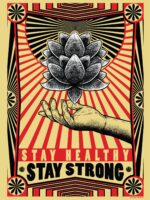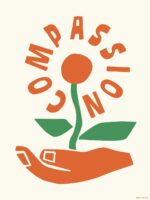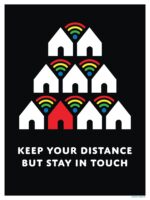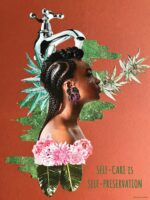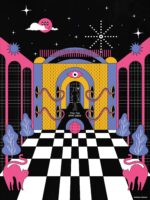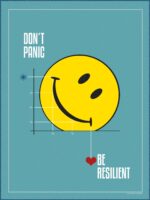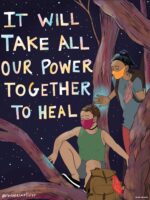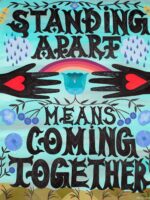Exploring Art, Teraanga, and Social Change With Partcours at the Wellbeing Summit Dakar-ThièsExploring Art, Teraanga, and Social Change With Partcours at the Wellbeing Summit Dakar-Thiès
Learn about the upcoming collaboration between the Wellbeing Summit Dakar-Thiès host, Tostan, and renowned Senegalese art festival, Partcours.
In the heart of West Africa, where the vibrant culture and traditions of Senegal meet the challenges of a rapidly changing world, an extraordinary event is set to unfold: the Wellbeing Summit Dakar-Thiès, hosted by Tostan in partnership with The Wellbeing Project, promises to be a source of hope and inspiration for social change across the continent. At the core of the first Regional Wellbeing Summit in Africa will be a collaboration with Partcours, one of Senegal’s leading contemporary arts festivals. In the 12th edition of this renowned event, a new exhibition, “Yoonu ci biir (The Inner Pathway)”, will explore stories of inner journeys towards wellbeing through the eyes of local artists.
Wellbeing in a Changing World
In a world grappling with unprecedented challenges, the concept of wellbeing takes on a profound significance. The creation of art can be an act of hope; an expression of joy, anger, celebration. Art can provoke us to take action, move us to tears or laughter, and the creative process itself can be integral to our wellbeing.
The Wellbeing Summit Dakar-Thiès is an African-led, African-based initiative, bringing together local, national, and regional leaders. At the heart of this summit is the idea of Teraanga, a cultural concept rooted in Senegal. It reflects the belief that we are all interconnected and interdependent. What affects one individual or community has a ripple effect, impacting everyone. This concept will be reflected throughout the Summit through a dedicated space for discussion and action centred on wellbeing in the African context.
Teraanga reflects the belief that we are all interconnected and interdependent. What affects one individual or community has a ripple effect, impacting everyone.
An integral part of this discussion is the critical role of the arts in fostering creativity, self-expression, and wellbeing in diverse African communities. Believing in The Wellbeing Project’s motto – that wellbeing inspires welldoing – the Summit will explore the arts as a key tool for discovering and unlocking opportunities for social change.

The Arts for Wellbeing: Collaboration with Partcours
For this transformative summit, Partcours has teamed together with Tostan to curate an immersive art experience exploring the concept of wellbeing. The exhibition, “Yoonu ci biir (The Inner Pathway),” will feature the work of two remarkable local artists, Fatim Soumaré and Omar Diouf (Yafane), who have taken unique paths to find their creative practice and viewpoints on wellbeing.
“Art allows me to express, without constraints, my hopes of connecting with our ancestral practices and oral traditions. My works not only reflect cultures inherent in African craftsmanship; they also subscribe to an interdisciplinary dialogue. They bear witness to the progress and ingenuity of collective practices to develop and sustain social and economic activity. Through the thread-craft traditions of the women’s collective I created in 2021, I explore the traces of their existence to ensure the collective preservation of their material and immaterial memory.”
Fatim Soumaré is a Senegalese artist living in the Sine Saloum region who has a deep passion for textiles. She has preserved the ancestral African tradition of falè, the hand-spinning of organic, rain-fed cotton. Fatim’s art is not just a visual experience but a tactile and emotional one. Through her art and home textile brand, she employs a collective of 200 craftswomen, connecting them to their heritage and a source of livelihood.
“Art allows me to express, without constraints, my hopes of connecting with our ancestral practices and oral traditions. My works not only reflect cultures inherent in African craftsmanship; they also subscribe to an interdisciplinary dialogue.”
— Fatim Soumaré


Omar Diouf, also known as Yafane, is a self-taught artist from Mbour, Senegal. A farmer by day, his artistic universe is adorned with diverse and beautifully recycled materials, from shells to mirrors to plastic waste. He infuses his lived experiences in his artwork, bridging elements of sustainability and creativity in his creations.
“For me, art contributes a lot to my community. My creative knowledge and abilities are companions for both me and my community. Art contributes to our African cultural heritage and is an important legacy for the benefit of future generations.”
The art installations, thoughtfully created by these two artists, will be showcased at the Sococim Foundation Cultural Center in Rufisque, near Senegal’s capital, Dakar. The opening night will coincide with the Wellbeing Summit Dakar-Thiès, bringing together artistic expression and reflections on wellbeing from an African perspective.
“Art contributes to our African cultural heritage and is an important legacy for the benefit of future generations.”
— Omar Diouf (Yafane)
This collaboration is a unique opportunity to connect local changemakers, artists, and wellbeing practitioners from across Africa to share ideas and experience the profound impact art can have on wellbeing, and wellbeing on art.
As Partcours’ curator Mauro Petroni noted, “Our two featured artists’ inventions explore very different paths. However, both start from their own intimate lives and arrive at the same point.”
In Yafane’s work, he explained, we can see a forward journey from his roots. As a farmer, he lives in a field that is his space and his workshop. Completely self-taught, he accumulates all sorts of things and arranges them to achieve an expression of skilful simplicity. This allows him to go wherever and land wherever – totally uninhibited.
Meanwhile, in Fatim’s pieces, we can see the reverse as she journeys towards her origins. Having set off from another world, she comes to the collective source to rediscover the simple wisdom of tradition. From there, she continues a journey without contradiction into the poetics of woven thread and the social lives of women artisans. She takes us with her, with her lightness and her laughter.
Petroni concluded, “At some point in history, thanks to wellbeing, they crossed paths. Fatim and Yafane will be our guides and our examples, teaching us the understanding and expression of their human experience.”
Fatim and Yafane’s creations will be one part of the Wellbeing Summit Dakar-Thiès’ larger programme, which will feature local and regional arts and music to help foster self-reflection and shared connection. West African song and dance, contemporary art installations, and theatre will be woven into the Summit – inspiring a unique individual experience that can lead to collective action and wellbeing for all.
“Yoonu ci biir (The Inner Pathway)” will open on Thursday, 30th November at 17:30 at the Sococim Foundation Cultural Centre, where attendees can meet the artists who will participate in a dialogue on art and wellbeing.
Those in Senegal can enjoy the exhibition from 30th November to 31st December 2023 as part of the collaboration between Partcours and the Wellbeing Summit Dakar-Thiès.
Celebrating ShōkakkōCelebrating Shōkakkō
The Art of Life’s Little Joys
TheMerode’s latest exhibition invites happiness in all its forms to the Wellbeing Summit Brussels
Can the answer to one of life’s greatest questions – what is happiness? – be found in the smallest minutiae of daily life? Shōkakkō, the latest art exhibition at TheMerode club in Brussels, invites us to explore this idea by celebrating the serendipity that comes from cherishing the small and simple. We are thrilled that Shōkakkō will be at the heart of the first Regional Wellbeing Summit in Europe, which TheMerode will host from 16th-17th November, where themes of joy, mindfulness, and wellbeing will converge. Following the success of our Global Summit in 2022, the Wellbeing Summit Brussels will continue building the wellbeing for social change movement by embracing a central theme – “moving from ego to eco” – and embarking on a transformative, multidimensional journey to connect our individual wellbeing with that of our communities and the planet, envisioning a holistic approach to social transformation.
Coined by best-selling author Haruki Murakami, shōkakkō is a Japanese term that captures the essence of small joys — the tiny moments of delight that, while perhaps found in the mundane and ordinary, are foundational steps in our path to happiness. In small sensory experiences and fleeting seconds of feeling, you notice tiny sources of happiness all around you. You might enjoy noticing them by yourself; you light share a smile or a laugh with others as you do so. These are shōkakkō: your humble, quiet, and little pieces of joy.
小確幸 (shōkakkō) • noun • small but certain happiness

The Shōkakkō exhibition is one that, in representing a community’s views on happiness, puts collective thinking at the heart of contemplations on happiness. The exhibition speaks to the fundamentals of human relationships, offering a step back from individuality in order to focus on the collective and the joys that come from feelings of belonging. With the Wellbeing Summit Brussels’ theme in mind – moving “from ego to eco” – the exhibition seems to suggest that happiness and, to a larger extent, wellbeing, can be found in the sharing of experiences and contemplating life’s joys with others.

For the exhibition Shōkakkō, TheMerode asked its members their definition of happiness and, embracing the emotional, experiential diversity of their responses, curated a colourful selection of works from 54 artists that embody members’ little joys. Visitors are able to wander around TheMerode and enjoy works from international artists offering views of happiness through a kaleidoscopic lens. As TheMerode’s curator Emmanuelle Indekeu said, “This exhibition doesn’t aspire to redefine happiness, but rather to collectively explore the myriad manifestations of happiness in our lives.”
Consider this art: to capture the epiphanies that heighten our sensitivity to the sheer act of being alive.”
– Patrick Chamoiseau

As we pursue wellbeing in our work to drive social change, remembering to notice and cherish our own shōkakkō is a beautiful and helpful practice. By slowing down, being mindful, and keeping an eye on the little things in life, we can invite a certain quietude, peace, and happiness into our hearts. We can remind ourselves of the small but mighty power of presence while, in our work as changemakers, we often find ourselves confronting some of life’s biggest challenges.
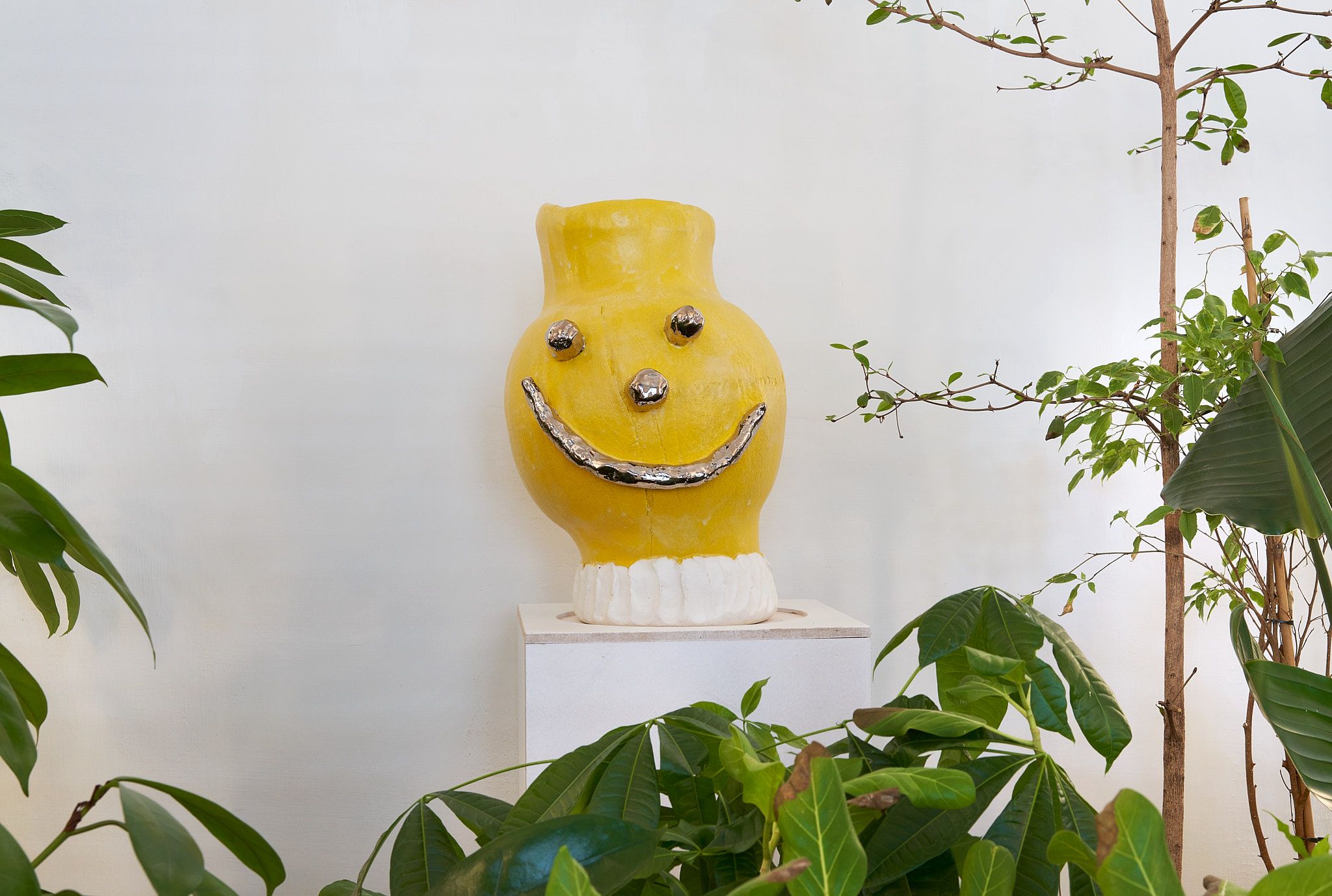
While European readers can enjoy Shōkakkō in-person at TheMerode during the Wellbeing Summit Brussels, the beauty of shōkakkō is its universal presence in all of our lives. To help inspire your own celebration of shōkakkō, we asked members of our community to reflect on the happiness in their own lives. Here’s what they said:
Happiness is…
“Made up of small, simple things that can affect each of us with our own sensitivity. One of the greatest joys for me is my freedom of thought and movement.”
“Looking at the sky first thing in the morning and mentally saying good morning to the world (and sometimes also saying it out loud).”
“A piece of chocolate in the afternoon”.
“Silence and chirps of birds in my 9th-floor home with busy Mexico City hustling below.”
“A good meal and a good drink shared with good friends.”

“My kids’ laughter.”
“I don’t know what happiness is, but I know what makes me happy and that’s more than enough.”
“Happiness is stronger when shared. Let’s embrace the happiness that comes from others, nurture sharing with our loved ones, celebrate the small wonders of life, and seek the spark of happiness in every moment.”
“My job: to convey the emotion of my thoughts to the customer through a dish.”
“The smell of my kitchen when I’m baking.”
“Tasting something I ate as a child and loved. The memories come flooding back.”

“When you release the expectations of others you then create your own happiness.”
“Passing by the garden at the entrance to my office office and being in awe by with the flowers and smells.”
“Watering my plants and seeing the sun filter into my apartment.”
“Watching my dog get excited about something.”
“My family. I had the incredible opportunity to grow up in a large family, and they’re my joy. All of them, in so many different ways, with so many different characters, in arguments, in laughter and in moments of sorrow.”
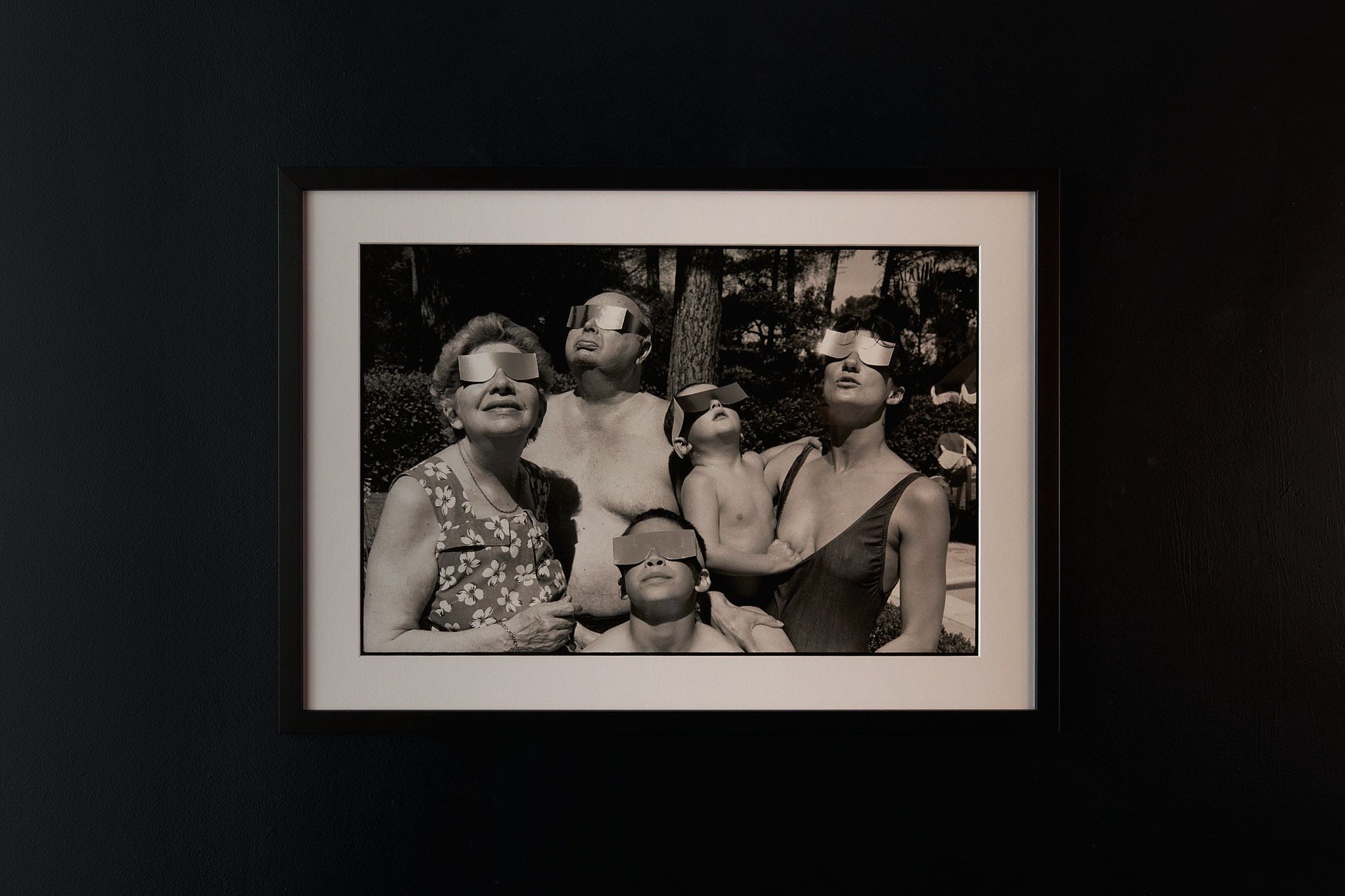
“Learning, sharing, helping each other and meeting new people.”
“Giving a hug to my kids in the morning or any time of the day.”
“Calm evenings of reading while my partner practices piano.”
“Tranquil night walks in the neighborhood park after dinner.”
“Opening the blinds every morning to let daylight into my home. It feels as if the world is welcoming me into life for one more day.”
“Closing the blinds and putting on my favorite show before bed. I made it through another day and I’m in my safe place. It’s time to rest.”

Enjoy the rest of TheMerode’s exhibition Shōkakkō at the Wellbeing Summit Brussels (16-17th November 2023).
Wellbeing in West Africa: How We Gather TogetherWellbeing in West Africa: How We Gather Together
Guest post by:
Carina Ndiaye, Chief Partnerships Office, Tostan
In Senegal, we call it Teraanga. It stands for openness and sharing, meaning: “we invite you to come in.” This cultural norm is present throughout the region and across the continent. Words like Ubuntu in southern Africa portray acknowledgment, respect, and coexistence. In Senegal, through Teraanga, the concept behind the Hindi word Namaste (meaning: “the light in me sees the light in you”) is extended and reinforced to say, “what is mine is yours.” This applies not only materialistically but also to the earth, the sun, the sea, and the unseen. From visitor to member, from transitory to influenced, in our culture, the ‘you’ never stands alone. What affects you also affects me and my community, and community includes anyone who walks our way and crosses our path.
As Tostan agreed to host the first African Wellbeing Summit, joining The Wellbeing Project and key partners hosting similar summits around the world, Teraanga has been a foundational concept for us. It is an entry point into the broader West African cultural systems that value people and their shared history and interconnectedness and that prioritize interdependence over independence.
Our upcoming African Regional Wellbeing Summit Dakar-Thiès 2023 reflects our dedication to embracing community-centered models that resonate with our core values. Locally-driven initiatives and capacity development for communities are critical paths forward, as our CEO Elena Bonometti has pointed out. But at the heart of our vision is Teraanga, where openness and sharing guide us in meeting the multifaceted challenges that our world faces. In Senegal, when challenges arise, a community gathering – referred to as a “pénc” in Wolof – is called to bring together the community for discussion. The Summit will be a globally-connected pénc, embodying the essence of African-based, African-led collaboration and growth in wellbeing. This is not just a “nice to have”; it is essential to our collective wellbeing and social cohesion.
There is a deep respect here for where people come from and for who and how they are. Many traditions create space for people to be seen, acknowledged, and recognized. Through greetings, names, joking, showing respect, and almost countless ways of engaging, we witness and reinforce one another. We see more clearly the threads interweaving our collective well-being. These traditions aren’t technical solutions or abstract topics; they are ways of meeting and gathering together, of creating spaces and openings where we can understand one another, share our perspectives and passions, and work better together.
With over 32 years of experience as a Senegal-based organization, welcoming partners from more than 50 countries far beyond Africa’s border, at our Tostan Training Center, we have come to understand that these ways of welcoming, these traditions for creating space, for seeing and being seen, can be powerful. As our global community seeks to find ways to support increased wellbeing in a context of increasing urgency and challenge, we hope our African Regional Wellbeing Summit Dakar-Thiès 2023 can contribute and share these ways of coming together.
Through our collaborative planning for the Summit, we have found some important themes to explore together. These include mental health, digital wellbeing, wellbeing in the workplace, and others. But the success of our conference won’t be limited to topics, action plans, or best practices. It will also depend on how people feel when they leave, how they can sustain connections, and whether they have found some new ways of inviting change into their lives, their organizations, their work, and our world.
About the African Regional Wellbeing Summit in Dakar and Thiès, Senegal
Join us for the first African Regional Wellbeing Summit in Dakar and Thiès, Senegal, hosted by Tostan from November 29th to December 1st, 2023.
The Summit will be an opportunity to engage in workshops, panels, and social moments to explore wellbeing, especially for those working in service for community-led development, from diverse African perspectives. Discover themes including mental health and its impacts on wellbeing, the role of religion, youth, and digital health.
Four Seasons Under One Sky: Arts as a Collective Approach to Creativity and Healing in South Africa Four Seasons Under One Sky: Arts as a Collective Approach to Creativity and Healing in South Africa
Guest post by:
Marlize Swanpoel
Co-Founder & Director, sp(i)eel arts therapies collective (Cape Town, South Africa)
sp(i)eel is an arts therapies collective (including drama, music, dance/movement, and art) of arts therapists, applied arts practitioners, and arts activists addressing intergenerational and complex trauma in South African communities. Over two centuries of colonialism and the oppressive regime of apartheid has left a nation grappling with systemic inequity and intergenerational trauma. Ongoing poverty and high incidences of violence and crime coupled with a dire lack of mental health services are contributing to complex and ongoing trauma, with more than a quarter of South Africans suffering from probable depression (Craig et al, 2022). This mental health crisis our country is facing is a systemic issue, not an individual one, and it needs a collective response. Our approach to mental health is culturally informed and sees people as each other’s greatest resource and source of support. As a result, our ultimate goal is to develop collective resilience that can affect social change.
Our name, spieel, is derived from two words that have different meanings in the Afrikaans language: “to play” or “mirror”. To “play and mirror” speaks to several reasons for our use of art as a healing tool. It refers to the function of the arts as a mirror to society for expression, reflection, and understanding. It also speaks to the therapeutic aspect of art therapies, where an art form is applied as a mirror to Self for exploration and understanding. Furthermore, it is through the playful nature of the arts that we can connect with our innate creativity.
It also speaks to the therapeutic aspect of art therapies, where an art form is applied as a mirror to Self for exploration and understanding.
In South Africa, access to therapeutic arts programmes is limited and not accessible to everyone. We aim to enable accessibility to the intentional use of various art forms to further have a positive impact on general health, wellbeing, development, and transformation for all.
Given our deep connection with the arts, our story and impacts can best be shared visually. This photo essay illustrates the journey of healing and wellbeing experienced through our Families and Collective Futures programme. It is a resilience-focused, trauma-informed programme that applies the arts and creativity to build psychosocial support systems. These systems are created through research (in collaboration with Brunel University), training, and the implementation of arts-based groups for children and their social circles.
The journey of this programme is presented within the frame of one of our core guiding metaphors: the four seasons. It represents the following. Firstly, just like the seasons, our mental health and wellbeing are not in a fixed state. We experience constant ups and downs. By accessing tools such as embodied awareness, reflexivity, and regulating skills, we can support ourselves and each other to navigate through these seasons of illness and health.
Secondly, this metaphor understands mental health and wellbeing in the context of the ecosystem. Communities are made up of people in different seasons of life. Collective resilience implies that the pressure to bounce back from hardship is not the sole responsibility of the individual. When one person suffers, it affects everyone. Everyone plays a role in collective health; as a collective, we are stronger together.
Collective resilience implies that the pressure to bounce back from hardship is not the sole responsibility of the individual. When one person suffers, it affects everyone.
Lastly, the seasons mirror people’s relationship with nature, and offer a platform to reflect on cultural and indigenous knowledge embracing nature as a source of healing.
We begin our journey in the season of (re)birth: Spring.
SPRING SPRING
Tending to the Soil So the Seedlings Can Thrive

In a community workshop, participants create an embodied image of Spring. A healing-centered approach to intergenerational trauma in family systems involves the adults developing reflective and regulating skills to take care of their own mental health, so that they are better aware of unhelpful patterns of relating in their families and community.

Arts activist Gershan Lombard facilitates a ritual of gratitude at the end of a community workshop, with the small children keeping a close and curious eye. Culturally-informed psychosocial practice includes honouring indigenous knowledge and spiritual practices of health and wellbeing to share this wisdom with the next generation.
Summer Summer
Young People’s Shining Stories

A group of young women share their story about Summer as a starting point to explore themes of health and wellbeing. It is vital to offer young people multiple ways to share their thoughts and feelings, as words are not always readily available to express their inner worlds. As one participant (grade 11, high school leaner) revealed to us:“You might have noticed that we are a generation that keeps to ourselves, and we don’t trust anyone with our feelings and our thoughts. Especially because we don’t know how to talk about our feelings and our thoughts. You have come to show us that we can also show you through our songs and through our dances how we feel and what we are thinking. And that is freedom.”

A young woman creates her “Glimmer Box”, a tool that supports participants to explore what resources are available to them to support their mental health and wellbeing. These include positive relationships, safe spaces, and activities that regulate their emotional states. Some of these are drawn, painted on stones, or represented by found objects in nature and placed in the box as tangible reminders of available support systems.
“You have come to show us that we can also show you through our songs and through our dances how we feel and what we are thinking. And that is freedom.”
Autumn Autumn
A Season of Trust and Letting Go

A couple rests back-to-back and connects with each other’s breath. Our embodied, trauma-informed practice is drawn from Stephen Porges’ Polyvagal Theory as a way to understand the autonomous nervous system’s responses. This helps us understand our reactions to triggers and to develop tools for regulating and finding safety and connection in the present moment. The couple shared afterwards: “My partner and I are having difficulties in our relationship. This workshop has given us the space to sit and just be with each other, to re-connect, and we were able to talk about things. This had a positive influence on our children and family life.”

In a workshop for mothers and daughters, mothers embody the support of a bridge, coming together to keep a girl above water. This workshop took place during a time of heavy flooding in the area in which some participants had lost their homes. This role-playing offered a way to express the traumatic experience: “The only way to keep safe is when we all look after each other’s children. We are not alone in this world, and your child is my child,” shared one mother. The embodied work where non-verbal communication is encouraged also supported bonding between mothers and daughters: “Girls don’t open up to parents, this exercise helped us to open up to each other,” said a young participant.
“We are not alone in this world, and your child is my child.”

A group embodies the word “women” in Circles of Support, one of our workshops for women. This workshop explores the female menstrual cycle as its four phases are linked with the four seasons, inviting conversations around menstrual and sexual health, menopause, and mental health and wellbeing. These circles are filled with generational knowledge, beauty, hope, and wisdom. One participant expressed her joy: “My experience was that I can be comfortable with myself as a woman. And I can express my feelings and accept my body. To be a woman is great!
Winter Winter
Embracing the Wisdom of the Elderly

A whole community, including the elderly, adults, youth, and children, are enchanted by a storytelling circle. We witnessed a beautiful moment where the children sat and listened to the stories of the elderly, and asked them questions about the history of their community. Such events where the stories of the elderly are centralized, offer a means to narrate collective and cultural history to the next generation.

Elderly men create their own Glimmer Maps to identify their “glimmers”: small moments when we are in a place of connection or regulation, which cues our nervous system to feel safe or calm – the opposite of triggers. They are made by tracing a hand on paper, followed by a symbol of nature representing the Self drawn into the palm. Each finger represents a glimmer with prompts from nature, for example: air for breath, fire for warmth, love, comfort and rest, water for movement, and earth for grounding. Finally, we connect the glimmers to our community, and include the name of a person who makes us feel safe.
Concluding Concluding
One Cycle, Inspiring Another
A core element of the Families and Collective Futures programme is the creative methodology. One participant reflected that the manner in which we engaged with them has helped people to come out of their shell, as “ons mense neem nie maklik deel nie” (“our people do not engage easily”). To help ease our participants out of these shells, we understand several contributing factors help create a sacred and safe space where mental health and wellbeing can be addressed:
A scaffolded approach to introduce arts-based work;
The invitation to engage in any way that feels comfortable;
The knowledge that attendance is voluntary; and
The modeling of respect, tolerance, and kindness.
The above learnings speak to a healing-centered approach to trauma and essentially it is a message of hope. When we work within the ecosystem in a culturally-informed way, it creates space for innate and indigenous knowledge to be heard and received. As a result, when we understand that healing is available to everyone and happens in relation to each other, we can create circles of psychosocial support that are resilient enough to affect social change.
When we understand that healing is available to everyone and happens in relation to each other, we can create circles of psychosocial support that are resilient enough to affect social change.

We conclude this photo essay with a reflection of a participant on the theme of seasons and the image of a Glimmer Map, made by a young girl. “Every season produces something for the other season so that, in the end, nature can provide for us. Everything is a circle. And we are all part of the cycle.”
About The Author About The Author

Meet Marlize Swanepoel
Marlize Swanepoel is a Dramatherapist and the founding director of sp(i)eel arts therapies collective, an NPO that addresses intergenerational trauma and co-create community-based models of mental health care that are culturally informed and relevant to the South African context. She serves on the Secretariat of the South African National Arts Therapies Association (SANATA) and is a guest lecturer at the University of Cape Town. She is an enthusiastic advocate for the Arts for Health movement in South Africa that speaks to healthcare from a global South perspective. She loves being in spaces of learning, unlearning and dancing.
Grateful: A Journal Reflection on The Wellbeing Project’s Ecosystem Network Grateful: A Journal Reflection on The Wellbeing Project’s Ecosystem Network
Grateful.
In so many ways, this word embodies my feelings and thoughts toward The Wellbeing Project’s Ecosystem Network.
My colleague, Kyla Carlsen, and I joined the Ecosystem Network in September of 2022. Though we joined this community of passionate, thoughtful, and dedicated changemakers for a short amount of time compared to when the network first begun, never did I once feel like an intruder.
From the beginning, we were greeted with such warmth and open arms that I knew virtually attending the Wellbeing Forums would be calls that I would eagerly anticipate every quarter. It did not take long for me to be captivated by the illumination of the Ecosystem Network because of the caring people creating and holding this space for changemakers to connect in such an intentional and authentic way.
One of the things I admired most about the network was the way this space was held for members to connect. I don’t ever recall joining a session where we immediately rushed into business or the tasks at hand. Instead, we were encouraged to participate in a collective grounding exercise or share how we were showing up in the space on that day. Taking this intentional pause to get grounded or share how we were honestly feeling was so astonishing to me.

Often in the nonprofit sector, we are hurrying through the day moving from one task or meeting to the next. This simple yet meaningful practice opened my eyes to how I could interact with my colleagues and facilitate meetings within my work differently. While meeting with members of the Collective Leaders Learning Circle program hosted by Co.act Detroit (pictured above), I was able to support with leading wellness practices for our group during some of our convenings. I felt confident to lead these practices thanks to my interactions and experience with members in the Ecosystem Network.
As a participant in this network, I loved being able to connect with other changemakers around the world. It was inspiring to hear about the work others were engaged in and the way they passionately served their communities. I still recall being amazed by Marlize Swanepowel’s presentation on the work she and her team does at Sp(i)eel concerning intergenerational trauma. Being able to connect with others over important and universal topics has made this experience such an insightful one.
One of my favorite gatherings as part of this network was when Anubha Agarwal of The Wellbeing Project shared findings from the Organizational Exploratory Program (OEP). This session resonated with me so deeply because one part of my work at Co.act is to lead our Nonprofit Wellbeing Series, which uplifts the vital connection between self and community care in the nonprofit community. To have the opportunity to hear about another’s wellbeing program and the lessons that have emerged was one I did not take for granted. I appreciated her transparency and that I was able to share some of the similar themes I saw in my work as well. Experiences like these continue to remind me why having collective space for people to convene and share is important.
As bittersweet as it is to say, “farewell” to the Ecosystem Network, I am grateful that there are still spaces for us to connect under The Wellbeing Project, such as through the Inner Wellbeing for Social Change group. To find ourselves in nourishing networks or spaces rooted in community and connectivity that are handled with so much care is something I treasure deeply. It is what I will miss most about the Ecosystem Network. While every beginning has an ending, I am grateful that the spirit of the Ecosystem Network will live on across the work of The Wellbeing Project and through the mindful practices and resources of its members. I have found so much joy, understanding, and inspiration from being a part of this community that I am forever changed and eternally grateful.
About The Author About The Author

Meet Charnae Sanders
Charnae Sanders, a devoted community advocate and Program Manager at Co.act Detroit, is deeply committed to fostering connections and empowering individuals. Her dedication to community development in her hometown of Detroit is evident through her work in curating impactful programs and events, including the Nonprofit Wellbeing Series. As a passionate contributor to the Rest and Liberation Initiative, she actively promotes holistic wellbeing and empowerment, particularly within BIPOC communities.
Charnae’s active involvement in various professional initiatives, such as the Young Nonprofit Professionals Network of Detroit and The Social Innovation Forum’s Community Organizations Reimagining Ecosystem (CORE) cohort, reflects her continuous efforts in promoting growth and leadership development. Her diverse experiences, including her time with the Challenge Detroit fellowship program and The Black Healing Justice Project, have further enriched her understanding of social impact and community engagement.
Prior to her role at Co.act Detroit, Charnae served as the Public Programs Coordinator at the Detroit Historical Society, utilizing her background in journalism from Central Michigan University. Her passion for writing and poetry has led to publications in renowned outlets such as the Wall Street Journal and Detroit Free Press. In her leisure time, she finds joy in writing, traveling, and experiencing the vibrant culture of her beloved city.
Organizational Wellbeing: Transition and Changes + Wellbeing Organizational Wellbeing: Transition and Changes + Wellbeing
Guest post by:
Michelle Arevalo and Ramses Gomez
As I was preparing myself for hosting this interview, I found this quote by Heraclitus that says “There is nothing permanent except change” and when I read it a lot of questions started to come up: Why is it so scary, sometimes? Shouldn’t I be used to it? Why do some people refuse to change, then?
I have to admit that I spent some time trying to answer them (…without feeling any better, actually) before remembering the reason why I started to read about change; so I decided that instead of trying to solve my doubts alone, the interview with Michelle and Ramses was the perfect opportunity to share all these inquiries, both leaders and open people that have transitioned recently and maybe with their help I could find some answers for me and you.
The first question I asked them was which’s the most important thing they have learned from this moment of transition as a leader, it could be something on a personal and/or professional level.
Michelle: I have learned that the saboteur voices in our head are always the strongest when we’re going through a transition […] We all have this illusion of progress; that the next thing you do is better than the last thing you did, but it’s actually all cycles. […] So I see myself going into this transition as another cycle, not better, not worse than my last one, but it’s still a cycle and it’s a beginning and at the beginning, wherever you are, no matter if you’re, the CEO of the world […] or starting your own social project […] the saboteur voices take on a very different strength […] Learning that I’m putting my finger on it and saying: “Okay, voices, you’re a bit stronger today, It’s not me”, this “I’m listening to you more” has helped me a little bit more in maintaining peace and calm as I start a new cycle […] because it’s very easy to be hard on yourself when you’re starting something new.
Ramses: One of the most important insights that emerged from the process of transitioning for me was the realization that I work from, I don’t work for. […] The organization, regardless of the role that I play, must provide me with the opportunity to help build the society I want to live in, […] an equitable society, a fairer society, a more caring society for people and the planet. […] I’ll say that knowing that I work from and not for, liberates me in so many ways because taking the transition or the step to transition comes with personal judgment, potentially outside judgment or outside voices […] and just realizing that we are way more than just our roles and titles, it unlocks a beautiful potential for everyone.
After reading several times both answers while I was writing this document, I noticed that in their own way and with the help of each particular process, they increased their awareness about what actually motivated them to transition like the values, in Ramses case; and how they are living the process, noticing these unconscious thoughts or saboteur voices, like Michelle accurately called them, that sometimes avoid us of from taking big steps.
Listening to their learnings made me want to know if there was any recommendation or advice they would like to share with people facing a transition process and here is what they said:
Ramses: It’s important to call things for what they are. And transitions are transitions. In the bigger scheme of things, transitions are also evolution and when you put it like that, it makes things way less scary. […] It becomes more natural. Of course, it comes with challenges and pains and complications, but most of those complications are attached to a mindset that is something that we own and, most of the time, we have built […] If we realize it’s within us, then we can much easily (I wouldn’t say super easily) change it.
Michelle: One thing that you have to start with is just by being kind to yourself because you’re doing something brave. The two things that I would say, one is very practical. Think of your transition as something beautiful and something you need to sit on because we are so used to thinking, “Oh, what’s the next thing? What’s the next thing? I can’t be in a transition for too long”. […] If you sit with yourself and enjoy the transition, you will find out things about yourself that will allow you to take the next step willingly. If you go towards the next step to avoid your transition overall, then you might be escaping from something and you never want to feel like you start something as if you had escaped from something else. […] Nobody likes that feeling.
The second one is probably the hardest and the one that takes the most courage: Talk about things openly and a lot. A lot like: “if you think you’re done talking about it, talk about it again” because […] sometimes we don’t take chances because of the impact it has on others. […] In my case, I knew that it would impact my business partners, my team, my managing partner […] but once I talked about it […] The conversation that came from the heart was basically, “Wow, this is going to impact me, but I am with you.” […] If there’s something that you need to do, have the open, difficult conversations first, because in the long term, it would be better for sure.
Ramses: What I wanted to share is something that was very valuable for me and much connected to what Michelle was saying and the reason why I wanted to go back: “Being honest in moments of transition and it starts with you being honest with yourself, which is quite challenging” Then it has to do with […] colleagues and very close people and friends that will be affected or impacted by your decision. […] Something that I have constantly made sure that happens in my transitions […] is that for the last two weeks I made sure to book time with absolutely EVERYONE in the organization that I worked with […] I booked time aside, usually it’s outside the office […] and asked them three questions: The first one is, what’s your favorite memory of the two of us? […] then the second question is, what did you enjoy the most while working with me? And it might seem like it’s that you want to hear praise from others, but it’s just a mechanism to prepare them for the last question, which is […] what advice do you have for me before I start my new journey? […] I make sure that I have this conversation with a piece of paper and a pen so they write down the answers and then they read them to me […] I keep those papers in my night table and when I’m going through a difficult situation, it’s usually where I go for inspiration because that’s when people have been the most honest about who I am.
Sometimes when we face difficult or complicated situations, we can forget about taking care of our wellbeing, that is why I asked both members if transitioning affected them in that way, or maybe it didn’t.
Michelle: Caring for my own wellbeing is, in part, what prompted thinking that I needed to transition. […] Many people think of a transition like a breakup […] I think that I needed a different new challenge and that having my identity be so tied to my social enterprise was something that I needed to break up with. […] “I am not my project and my project is not me” and I wanted to prove myself; it was a big part of making sure that my wellbeing becomes whole. […] Going into a transition puts you in situations that are outside your comfort zone and I don’t think that’s bad for your wellbeing. […] Thinking that being outside your comfort zone is bad for your wellbeing is actually not the right way to think of this algorithm; it doesn’t work like that. […] You have to be a little bit outside your comfort zone so that your brain grows in many ways and gets you to places you never thought you could be. […] Transitions are hard, but they’re not necessarily hard because they’re bad for your wellbeing.
Ramses: In a way it provided me with […] so much clarity about what’s relevant for me and what’s needed in the new phase / organization / role / costs. What is it that I need to be existent in that new opportunity that will get me so excited to the point that will be relevant for me to look after it. […] And of course, that clarity usually is tied to complexity, you have to go through complexity to see the light. So, […] in that sense it was absolutely challenging and I wouldn’t say my wellbeing was affected […] There were many nights awake, many times where my emotions were so confusing and different and, in many cases, new and unexpected that… […] I was honestly going through a very vulnerable time, when things affected me or impacted me in ways I wasn’t expecting. But I think the beauty of the process is that, […] it provided me and forced me to bring clarity to my thinking by being in connection with what’s relevant for me.
The last two questions are more personal. Before doing this interview, I had a little context of Michelle’s transition process and I matched it with one of the ideas that came out from the Wellbeing Summit feedback session with the Ecosystem Network. Therefore I asked her: When did you know or how did you know when to step aside? How did you know that your personal project is ready to fly without your direct guidance?
Michelle: I think you have to start from an earlier question, which is: Not when, but why. Why would you want to step aside? […] in my case I had a very good clarity that someday I would step aside and that my project will transcend me […] I’ve seen a lot of people take sabbaticals and take breaks because it’s important to take a step aside, even momentarily. […] It’s not always the answer but, in my case, it was and I knew it for a couple of reasons: first I started thinking even more long term than the usual manager would. […] One day, really out of the blue, (maybe it was deep in my heart) I just answered: “My biggest dream is that IMPAQTO transcends me in whatever shape or form”. And that’s when I knew in my mind that I was thinking way longer term and my everyday actions after that started to change; I started to delegate more, I started to think less about the day to day indicators and I started seeing my team flourish[…] And there was a day when I just felt like, “Wow! this is right, this place can actually continue on without me”. Of course, there were also outside voices that were not very nice, a lot of people called me and said: if you step back, your business partners or investors are going to be angry, they invested in you […] I would just take that as feedback and that told me that I’m doing the right thing because that’s not what I was looking for.
I also knew I needed my identity to be more than just this specific project and, in my case, I already had the privilege of having gone through a previous transition before. I used to be a Human Rights lawyer; I worked with refugees in Asia, in Africa, in Latin America; I worked in Geneva, in Switzerland so I already have taken a big lead in a transition in a different way in my career; back then I also knew that the death of my dog prompted it, that grief prompted it.
And I knew it when I started listening to a voice deep down that was telling me to move on but also, I knew it because it was important to my wellbeing along with many things that I learned from The Wellbeing Project itself. […] in my case, TWP means that the social impact we’re doing with IMPAQTO now has a tremendous opportunity to continue growing and that it doesn’t depend on me, and that I can continue doing IMPAQTO in other places. It all comes from this awareness of me being a person separated from my project and all that awareness came from conversations with Xyme, with my colleagues and feeling that this is not something that I made up, you all put words to what I was feeling.
Finally, I also knew that Ramses had transitioned in the past, so my personal question to him was if he had faced any special challenge in his most recent process.
Ramses: This transition was the hardest and the easiest at the same time. It was the hardest because I had been at Sistema B for over 5 years and the organization was perfectly aligned with my values, with what I want to build for the world, the people, the colleagues, everything was a perfect match. So, in that sense leaving an organization that it’s so aligned is quite challenging. But when I say that this transition was the easiest, it’s because I could also see that the same values, vision and spirit was there, yet what was new and different, is the scale of the impact through the lense of a tech company.
I think that also what’s powerful with every transition is that it opens up the opportunity for new leadership to emerge and flourish. The more conscious the leaders happen to be about that aspect, the more they can catalyze it. So, I think all of us having meaningful, very honest and sometimes raw conversations with team members about how potential can be unlocked by an opportunity like this, but it has to be a co-construction; […] just to make sure it goes beyond the romanticism of the idea, but actually, one has to be very involved in the process of leading and making sure that there are the right conditions for everyone to take on it.
When the time of the interview was coming to its end, both members expressed some beautiful words about it:
Michelle: At least for me, such a welcome break… to have someone ask you deep questions and to think through the answers and to put your thoughts into words is very powerful. It’s a good format to think through different challenges. Thank you so much for asking thoughtful questions.
Ramses: It resonates with me a lot, thank you so much for the space, as Michelle and I always discuss how much we love the concept of “holding the space”. Thank you for holding the space for us because many wonderful things emerge when the space is curated well, when we realize that everyone has something valuable to say and even if the 2 of you are not speaking, the value comes from you having created the space. It wouldn’t happen if it wasn’t because of you. We all have to realize this is the contribution of everyone for beautiful things, valuable things have emerged and I’m just grateful for having the space where I can share things that are very personal but also that I feel very confident sharing outloud.
Michelle: This space that you are holding for us is also accessible for so many other people.
By the end of the interview I felt very inspired and motivated for changes; I thought about the future and the new beginnings I would face. But I think more important was that listening to them gave me the opportunity to reflect about my own processes and the way I am living them. I hope you have enjoyed this interview as much as we did.
A commitment to wellness and innovation: Design Factory Javeriana Bogotá A commitment to wellness and innovation: Design Factory Javeriana Bogotá
Guest post by:
Lucas Ivorra Peñafort, Coordinator of the Design Factory Pontificia Universidad Javeriana

The Design Factory Javeriana Bogotá (DFJBOG) was born on August 4, 2016, to strengthen the efforts of the Pontificia Universidad Javeriana (PUJ) to better articulate with different internal and external stakeholders of the University, to address different challenges of society that the university could tackle through the development of products, services, or strategies. It also aims to strengthen the Innovation and Entrepreneurship Ecosystem of the University. The commitment of the DFJBOG, managed by the Faculty of Architecture and Design in Bogotá (At the PUJ campus in Cali the Design Factory is in the Center for Innovation and Entrepreneurship), fits the mission of the PUJ under the Jesuit principles in the pursuit of the integral education of people, while being respectful of human dignity.
Educating people must 1) Transcend the merely technical aspects of education which, although important, are insufficient for a comprehensive education; and it must 2) Contribute to the satisfaction of the diverse human needs in the educational processes, not only those related to the curricular content of each course, but those linked to the whole set of material and non-material human needs. Thus, including well-being in the pedagogical dynamics is key to 1) Having more enriching and integral educational processes and 2) Contributing to the physical, mental, and spiritual health of the educational community. At the DFJBOG and the Faculty of Architecture and Design we consider it important to join the efforts of TWP Higher Education Network. Basically, with our involvement in “The Wellbeing Project’s Higher Education Network” we want to 1) Strengthen the activities that PUJ has been conducting to be a better place to study and work; 2) Share our good practices and lessons learned in terms of wellbeing and innovation, to enrich the processes in other institutions; and 3) Learn from the good practices and lessons learned from other institutions.

Currently, at the DFJBOG and the Faculty of Architecture and Design, we have been advancing and supporting different initiatives that contribute to the well-being of our university community. From the different Vice Rectors’ Offices, we develop community building and integral health activities with our Center for Cultural Management, the Center for the Promotion of Identity and Community Building, the Javeriana Center for Sports Training, the Center for Psychological Counseling and Health, the Center for Learning, Teaching and Evaluation, the San Francisco Javier Pastoral Center, the cultural events of the Faculty of Arts, the personalized support of the Academic Counseling, among others.
In the DFJBOG, one of the main bets for wellness is our Open Mind Fridays, where we conduct community and trust-building activities, which are not related to classes or projects. For example, we have developed kite and cookie-making workshops, relaxation sessions, movie and pizza afternoons, and singing and dancing sessions, among others. In this line, following the initiative of Professor David Osorio from the Faculty of Economics and Administrative Sciences, we joined the sessions that he and Professor Jairo Hurtado from the Faculty of Engineering had been conducting with game afternoons with students, lecturers, and friends. To paraphrase Professor Jairo, this initiative, which we agreed to call “Game Fridays,” strengthens the physical and mental health care of our students and contributes to building richer and closer relationships in the educational community. More recently, the Cultural Management Center offered us their support to increase the reach of Games Fridays with the Cultural Management Center’s initiative called “Fridays at Sunset”.


After more than five Games Fridays sessions held jointly, we are planning to move on to the next stage, with the participation of the Faculty of Economics and Administrative Sciences, the Faculty of Engineering, and the DFJBOG with the support of the Faculty of Architecture and Design. This new stage seeks to combine and strengthen the participation of more people from the three faculties involved, extend the impact to other faculties and units of the University, and merge and document the lessons learned and impacts achieved by this initiative.
Thank you to our TWP Higher Education Network colleagues for having us, and we trust that we can make a significant contribution to the network’s efforts to improve educational processes in an innovative way and the pursuit of the well-being of all involved.









